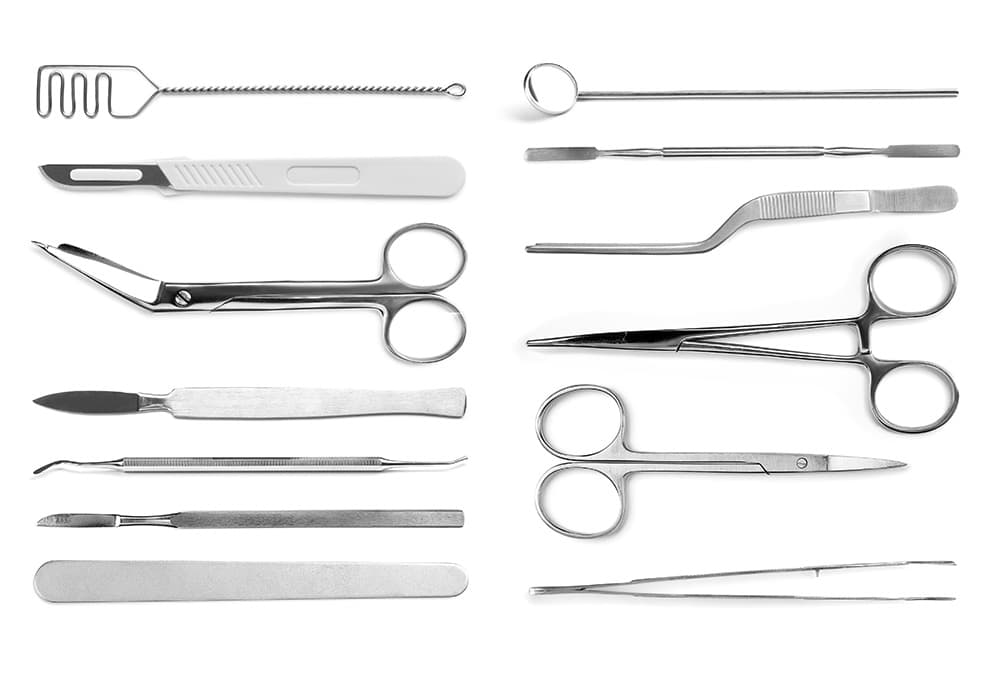
The term “stainless steel” applies to iron-based alloys that contain 11% chromium or more. This formulation helps prevent corrosion and also makes items formed from the material more heat-resistant. As a result, stainless steel devices—from kitchen appliances to medical instruments—have a well-deserved reputation for stain resistance and durability.
Stainless steels (called “chromium steels” in the early 1800s when their stain-resistant properties were first identified) come in various forms that are grouped into what are called: series. The 200 series steels include chromium, manganese, and nickel along with iron. The 300 series, which includes chromium, nickel, and iron, is the largest and most widely used group. The 400 series has between 11% and 27% chromium and little to no nickel.
The microstructure of stainless steels resists corrosion and discoloration.
However, when it comes to the actual performance of stainless-steel devices in healthcare or dentistry—which often use 304, 430, or 431 stainless steel—it is important to understand how the word “stainless” should be interpreted. Specifically, rather than meaning “without stains” or “unable to be stained,” it should actually be thought of as “stain less” as in, “items made from this material will stain less easily.”
The reality is that because of its iron content, even stainless steel can become stained or discolored when used in extreme environments such as:
- High pressure
- High heat
- High moisture levels
And those characteristics are very common in medical and dental procedures.
What’s more, devices must be meticulously cleaned and thoroughly sanitized after each use. And those processes take a toll on the structural integrity and appearance of instruments.
Why Both Functionality and Aesthetics Are Important in Healthcare and Dentistry
In order for doctors, dentists, and other professionals to get the results they are looking for with a procedure, they have to have medical devices that perform as designed and as expected every time they are used. The margin for error in these activities is small at best, and non-existent in many instances.
If a blade doesn’t cut cleanly or a clamp doesn’t hold firmly, the success of a procedure may be compromised. And in some scenarios, a faulty device can become a serious risk to patient safety.
But how a device performs is only part of calculating its value to a user, and beyond that, to the reputation of a medical or dental practice. No skilled professional wants to pick up an instrument and see that it is etched, corroded, stained, or discolored. If asked to work with devices that aren’t in like-new condition, many care providers might understandably feel disrespected to a degree—or, at least, inadequately equipped to complete their task at hand with the degree of precision required.
Patients tend to have a similar reaction to observing devices that have unsightly stains and visible wear. Glancing over at a tray of instruments with the expectation of seeing nothing but flawless, gleaming metal and instead, seeing blotchy or discolored tools can be disheartening or even concerning–especially when considering they are about to undergo a procedure and might already feel stressed or nervous.
Chromium Coatings for Medical Devices: Powerful, Affordable Protection
While the chromium used to create stainless steel provides a measure of defense against dulling, discoloration, and other issues, adding a coat of it to key surfaces takes that protection to another level. Applied with an electrolytic process, the chromium bonds to the base material, greatly increasing the durability and stain resistance of the device.
Inert, non-magnetic, USP Class VI, Tripartite/ISO, and antimicrobial chromium coatings with thicknesses of 0.00004” to 0.001” per side (1.0-25.0 microns) can be applied to a wide range of stainless-steel devices, including:
- Saws
- Drills
- Orthopedic tooling
- Endoscopic cutters
- Taps
- Dental reamers
- Handles
- Housings
- Tubing
- And many more…
Chromium can also adhere directly to aluminum. And wherever it is used, it will not chip, flake, or peel.
ME-92® Chromium Coating: Extensively Tested and Certified Biocompatible
Any material that comes into contact with a patient’s body during a procedure must be fully biocompatible. ME-92® coatings have undergone extensive testing—for toxicity, sensitization, pyrogenicity, and more—and met or exceeded the highest safety standards.
That is one of the many reasons that these coatings are trusted by a wide range of stakeholders, from medical device designers and engineers to leading manufacturers. And ME-92 Operations can apply chromium coatings on everything from prototypes to small runs to million-piece orders, always with absolute precision. ME-92 also offers mask coating, so we’re able to add a coating to a specific portion of the tool with exact precision, potentially saving you money on coating costs.
Once coated, stainless-steel items that might have begun to show signs of wear after just a few use/cleaning/sanitization cycles can maintain their sharpness or other functional characteristics, and their like-new appearance, for hundreds of uses.
So, for users who expect more than stain-less from their steel medical devices, chromium coatings from ME-92 deliver.